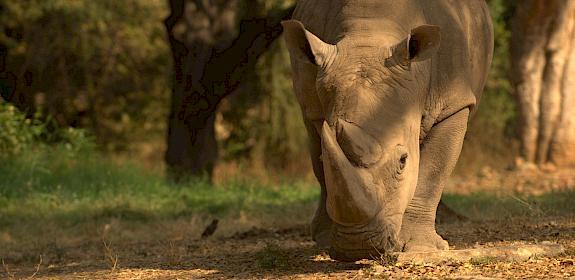Current Zoonotic Diseases Challenges In The East Africa Region
East Africa, with an abundance of free-ranging wild animals, livestock transhumance, and interactions between animals and humans at various interfaces, combined with a tropical climate, hosts favourable conditions for transmission risks of various zoonotic diseases.
This piece was authored by Dr Daniel Mdetele, TRAFFIC’s Senior Project Manager – Wildlife trade and One Health in East Africa, who is leading TRAFFIC's efforts to reduce risks in Tanzania's game meat industry under funding from the German government-funded International Alliance Against Health Risks in Wildlife Trade, which is implemented in parallel with TRAFFIC and IUCN's work under USAID Wildlife TRAPS. This article was written for World Zoonoses Day 2023 and has been published in national and East African regional news outlets, including Tanzania Daily News, MTanzania and InfoNile.
Zoonotic diseases are infectious diseases that are naturally transmitted between animals and humans. As these pathogens move between wildlife, domestic animals, and humans, understanding the specific mode(s) of transmission is crucial for implementing appropriate preventive measures and controlling the spread. East Africa, with an abundance of free-ranging wild animals, livestock transhumance, and interactions between animals and humans at various interfaces, combined with a tropical climate, hosts favourable conditions for transmission risks of various zoonotic diseases.
Direct contact is a primary mode of transmission for many zoonotic diseases that occur through touching, handling, or being bitten or scratched by an infected animal. Rabies, brucellosis, and anthrax are common examples of directly transmitted diseases.
Indirect transmission involves touching surfaces or objects contaminated with urine, faeces, saliva, or respiratory droplets from infected animals. The Kagera-Tanzania confirmed Marburg virus disease outbreak in March 2023 is suspected of having originated from farmers searching in fruit bat roosting areas for bat faeces (also known as bat guano) used for fertilising soil. This is an example of indirect transmission.
Vector-borne transmission requires organisms to transmit pathogens from one host to another. Mosquitoes, ticks, fleas, and sandflies provide vectors for transmitting pathogens in this manner. Foodborne transmission occurs in the event of eating or drinking water contaminated with diseases causing pathogens like salmonellosis, campylobacteriosis, and toxoplasmosis. Airborne transmission occurs when infected animals or humans cough, sneeze, or exhale infectious particles into the air; diseases like influenza (bird flu), tuberculosis, and certain forms of avian coronavirus infections are among airborne diseases. Transplacental transmission is from an infected pregnant woman to her foetus.
Zoonotic diseases often result in ill health and economic consequences associated with the illness - yet they are not taken seriously in many contexts. They frequently occur in geographic locations where vulnerable groups within marginalised communities have limited access to health services. In some instances, developing countries deprioritise the needs of these communities, and they are not afforded sufficient attention. Zoonotic pathogens continue to emerge and spread across regions, including East Africa, and challenge public health by causing countless morbidities and mortalities, disrupting trade, and negatively impacting the economy in developing and developed countries, as it was during the COVID-19 pandemic.
The East Africa region often faces challenges maintaining strong veterinary and public health systems. Stretched or scarce surveillance and reporting systems make it harder to detect and respond to zoonotic disease outbreaks in a timely manner. Inadequate collaboration and coordination between veterinary and public health authorities further hinders effective disease control efforts.
East Africa is rich in biological diversity, and interactions between humans, domestic animals, and wild animals are common. Encroachment into natural habitats, poaching, and illegal wildlife trade increases the risk of zoonotic disease transmission. Diseases can spill over from wildlife to domestic animals and humans, posing significant challenges for disease control and health security. Awareness and knowledge about zoonotic diseases among communities, healthcare workers, and animal handlers is a challenge. Education and awareness campaigns about zoonotic diseases, their transmission, prevention measures, and the importance of timely behaviours in seeking healthcare are crucial for minimising the impact of these diseases.
Changes in temperature, rainfall patterns, and ecological conditions because of climate change affect the habitats of disease-carrying vectors, such as mosquitoes and ticks, potentially expanding their range and increasing incidences of disease transmission. Addressing these challenges requires multi-sectoral collaboration and investment in healthcare infrastructure, veterinary services, and public health systems. Strengthening surveillance and reporting systems, promoting research and innovation, and enhancing public awareness and education are vital for mitigating the impact of zoonotic diseases in East Africa.
In East Africa, recent reported zoonotic disease outbreaks have included the Marburg virus in Tanzania (March 2023) and Ebola in Uganda (January 2023). These viruses are highly contagious and can cause severe illness, often with high mortality rates. The reported leptospirosis outbreak in southern Tanzania is another contemporary example of zoonotic diseases of concern in East Africa. Over the years, the region has been struggling with a variety of zoonotic diseases, including rabies, brucellosis, anthrax, Rift Valley fever, bovine tuberculosis, porcine cysticercosis, African trypanosomiasis, salmonellosis, and borreliosis.
Handling and transporting animals and animal products increase the risk of zoonotic disease incidence and transmission. Working in forests for various reasons, including hunting, processing, and transporting wild animals and their products, are among the activities that predispose humans to zoonotic disease risks. Markets selling the meat or by-products of wild animals are particularly high risk due to the substantial number of new or undocumented pathogens known to exist in some wild animal populations, including those that co-exist with livestock and other domesticated species.
The most common animal species that are reservoirs for zoonotic diseases include non-human primates, bats, rodents, small carnivores, swine, rabbits, and dogs, so handling these animals needs great care. This does not mean, however, that they should be targeted for extirpation or removed from the ecosystem simply because they pose zoonotic disease risks. The balance of biodiversity is the most important consideration. Challenges including increased rates of human population growth and mobility, urbanisation, food preferences, and handling of domestic animals, together with human behaviour and cultural factors, are among the factors that have contributed to the decline of the delicate balance between humans and nature, and thus risks of zoonotic diseases transmission have been accentuated in some contexts.
Where some of these diseases result in a febrile illness (showing symptoms of fever) and may appear like malaria (which is endemic), clinical diagnoses may be missed. As a result, unnecessary use of antimicrobials by self-prescription has become a customary practice, which has resulted in increased antimicrobial resistance.
Historical global pandemics such as HIV/AIDs and Ebola both originated in Africa, and the first HIV/AIDS cases were reported in Zaire (now known as the Democratic Republic of the Congo (DRC)). The first human HIV infection dates from 1959, while AIDS, later recorded and recognised as a disease in 1981, evolved from non-human primates in and around East Africa. Outbreaks of the Ebola virus near DRC’s Ebola River in 1976 and then followed by an outbreak in a geographic area that is now within the country of South Sudan, were, at that time, fatal hemorrhagic fever. Fortunately, such outbreaks are intermittent.
In addition to the wide distribution of wild animals, habitats, and ecological niches in East Africa, the region is made vulnerable to zoonotic diseases by increasingly destabilised ecosystems (including deforestation, natural resource extraction and other forms of land conversion). When aggregated with increasing encroachment of wildlife habitats and human-animal contact, risks of the emergence and re-emergence of zoonotic and transboundary diseases from wild animals and livestock need to be better understood. Wild animals can harbour pathogens without showing any signs of illness. However, when such pathogens cross into susceptible livestock or humans, they can become infectious and cause morbidity.
Zoonotic diseases have primarily been studied on domestic animals, with limited knowledge of pathogen spillover between wild animals and humans. Livestock species can play a role as bridges for zoonotic disease transmission between humans and wildlife, with some of the pathogens being amplified when passing through livestock by multiplying and mutating, becoming infectious.
The emergence of novel pathogens from animal reservoirs due to certain changes in ecology increases opportunities for pathogens to enter the human population and could later result in transmission between humans. However, once this rare event occurs, then the subsequent transmission is maintained temporally or permanently, as exhibited by HIV, Ebola and the SARS coronavirus. On the other hand, pathogens such as lyssa viruses, Nipah virus, West Nile virus, Hantavirus, plague and leptospirosis are directly transmitted to humans from wild animals or through vectors and only rarely via human-to-human transmission.
The need for an integrated One Health approach towards managing zoonotic disease transmission and emergence, to reduce risks of epidemics and pandemics and increase preparedness is more vital than ever. Through the support of USAID and GIZ, in East Africa, TRAFFIC, a leading non-governmental organisation working to ensure trade in wild animals and plants is legal and sustainable, is undertaking a comprehensive project in Tanzania on zoonotic disease risk reduction in the trade, whether legal or illegal, of wild animals. These species are traded primarily as meat and other body parts for use as food. TRAFFIC’s work takes a value chain approach from source to end-use, including conducting a zoonotic disease risk analysis to evaluate the various human-animal-environment interfaces involved.
The project also includes considerations of context-specific factors such as socio-economic livelihoods and cultural considerations, a model that could be adapted at other sub-national levels in Tanzania. The project outputs aim to support the East Africa Community Secretariat in its One Health Action plan to minimise future zoonotic pandemic risks.
To support efforts improving the legality, sustainability, and safety for human health, under the USAID Tuhifadhi Maliasili activity, TRAFFIC is also working in northern Tanzania on social and behavioural change (SBC) activities to reduce poaching of wildlife and support positive shifts away from hazardous practices involving key stakeholders.
Illegal consumption of wild meat poses a significant threat to public health and global biodiversity. To mitigate the risk of zoonotic diseases and protect our ecosystems, there is a need for multi-sectoral collaboration, public awareness creation, and strengthening community and regional cooperation in risk mitigation measures and their application. It is crucial for individuals to understand the potential consequences and support sustainable and legal alternatives to the illegal trade in wild species.
About USAID

The United States Agency for International Development (USAID) is responsible for the majority of overseas development assistance from the United States Government and works to end extreme poverty and promote resilient, democratic societies while advancing security and prosperity for America and the world. www.usaid.gov/
About GIZ

GIZ on behalf of the German Federal Ministry for Economic Cooperation and Development (BMZ) and the German Federal Ministry for the Environment, Nature Conservation and Nuclear Safety (BMUZ) supports international cooperation for sustainable development and international education work to shaping a future worth living around the world. www.giz.de




